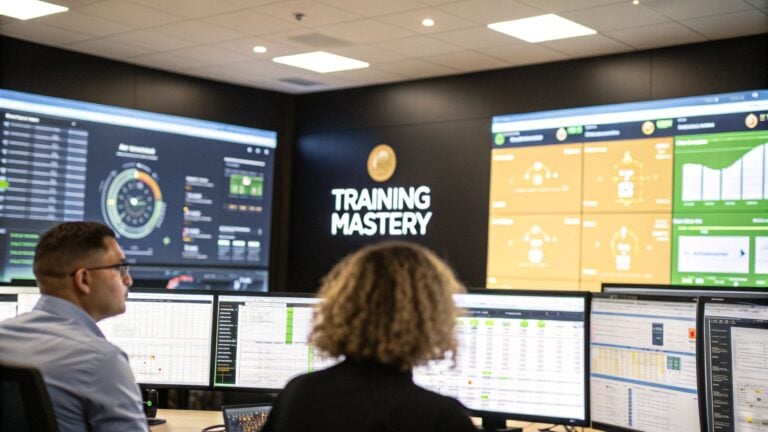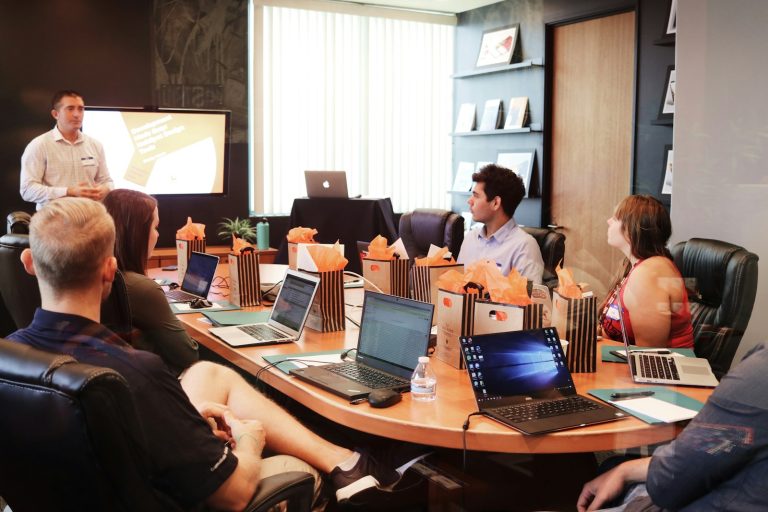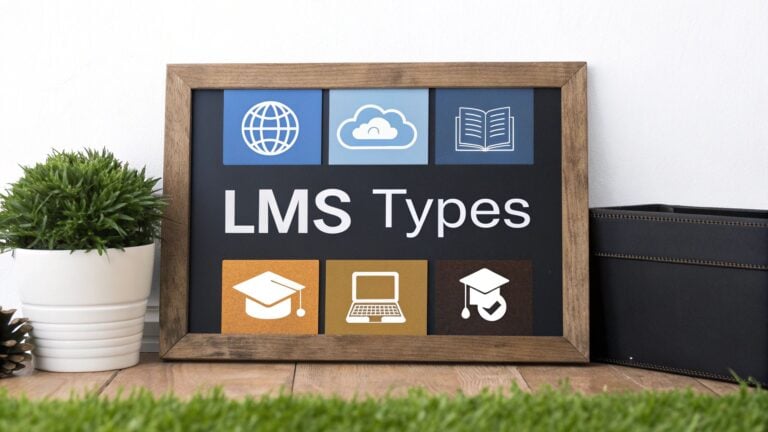Gamification for Training That Actually Works

We’ve all been there. Trapped in a conference room, staring at a PowerPoint deck, feeling our life force slowly drain away. The information goes in one ear and out the other, vanishing the moment you’re back at your desk. It feels like a colossal waste of time for everyone involved.
So, what if there was a better way to make learning actually stick?
Why Most Corporate Training Fails to Engage
This is where I’ve seen gamification for training completely change the game. I’m going to show you how sprinkling game-like elements into your programs is a powerful approach grounded in the real science of human motivation.
We’ll dig into how this strategy cranks up engagement, makes complicated topics easier to swallow, and helps your team actually remember and use what they’ve learned. Let’s ditch the forgettable presentations and start building training that people are genuinely excited to be a part of.
The Motivation Gap in Standard Training
The classic “sit and listen” model of corporate training is almost always missing one crucial ingredient: genuine motivation. Employees might dutifully click through the modules just to check a box, but the information never truly sinks in because there’s no personal investment.
This engagement deficit is a huge problem.
Without active participation, you get dismal knowledge retention, which ultimately means your training budget isn’t delivering any real return on investment. This is a common hurdle when creating a training programme that truly delivers results.
One of the biggest reasons corporate training falls flat is the lack of meaningful recognition. Something as simple as incorporating well-designed training certificates as motivators can start to bridge that gap.
A New Approach Backed by Massive Growth
Gamification steps in to fill this motivation vacuum. By introducing elements like points, badges, and leaderboards, it taps directly into our natural human desires for achievement, competition, and recognition.
And this isn’t just some niche idea anymore. The global gamification market is exploding, proving just how many organizations are catching on.
The market swelled from around $6.6 billion in 2019 to over $16.1 billion by 2023. Even more telling, projections suggest it could skyrocket to an incredible $132.6 billion by 2032.
This signals a fundamental shift in how we approach learning and development. We’re creating environments where people want to learn and improve instead of force-feeding them information. The whole dynamic flips from passive consumption to active participation, making the experience more effective and, frankly, a lot more enjoyable for everyone.
How Does Gamification Really Work?
So, what does “gamification” actually mean when you get past the buzzwords? I find it’s best to think of it as borrowing the best parts of games—the things that make them so addictive and compelling—and applying them to professional development.
Think about the core of any game you’ve ever enjoyed. You always have clear goals, you get instant feedback on how you’re doing, and you feel a real sense of progress as you move forward. These are the building blocks.
Gamification for training uses these same principles to make learning feel less like a chore and more like a challenge to be conquered. This approach designs a learning experience that taps into our basic human psychology.
Tapping Into Core Human Motivators
At its heart, gamification is a behavioral framework. It’s a design-led approach to shifting habits and building skills.
You simply pair specific cues (like a quiz question) with desired actions (like providing the correct answer). Then you add rewards—badges, progress streaks, or even just simple, immediate feedback. This creates a repeatable system that helps train behavior almost like muscle memory.
This whole approach acknowledges that people are driven by more than just a paycheck. We’re wired to seek out achievement, recognition, status, and competition. Gamified training speaks directly to these powerful internal drivers.
The Two Flavors of Gamification
It helps to know that gamification usually comes in two main forms. Most people only think of the first one, but understanding both can really help you design better training.
- Structural Gamification: This is the most common type. You take your existing training content and wrap game-like elements around it. Think points, levels, leaderboards, and feedback loops. The content itself doesn’t change, but the structure you build around it drives engagement.
- Content Gamification: This approach goes a bit deeper. Here, you actually transform the training material itself. You might turn the content into a narrative, a puzzle to solve, or a “choose-your-own-adventure” story.
Great gamification often uses a blend of both. You use the structure to create motivation with things like friendly competition and visible progress. Then you can use content gamification to rewire the material itself to match the way people naturally prefer to learn.
This diagram from Wikipedia shows how the core components—often called the PBL triad (Points, Badges, and Leaderboards)—work together.
What this really shows is how these simple elements create a feedback loop that reinforces learning and keeps people hooked.
The Power of Positive Reinforcement
There’s a great concept called “The Super Mario Effect,” which perfectly explains why this all works so well. The idea is that focusing on the goal (saving the princess) rather than the failures (falling in the pits) helps people stick with a task and learn more effectively.
By reframing the learning process, you take the fear of failure off the table. This allows learning to happen more naturally and enjoyably.
This is exactly why a positive, game-based approach can be so powerful. You’re creating an environment where making mistakes isn’t punished, but is seen as part of the learning journey. Small wins are celebrated, which reinforces progress over time and makes big goals feel much more achievable.
The result is less training fatigue and more genuine skill development.
Choosing the Right Game Mechanics for Your Goals

Alright, now for the fun stuff. Let’s talk about the specific tools in your gamification toolbox—the game mechanics you can use to build a truly engaging training program. We need to look past the surface-level points and badges to see what really hooks learners and gets them invested in their own growth.
Every mechanic serves a different psychological purpose. I’ll walk you through some of the heavy hitters, like leaderboards that spark friendly competition, progress bars that deliver that sweet hit of accomplishment, and storytelling that makes training actually stick.
The real secret is matching the right mechanic to your specific training goal.
Sparking Friendly Competition with Leaderboards
Leaderboards are a classic for a reason. They plug directly into our natural drive for competition and social standing. Seeing your name climb a list is a simple but powerful motivator that encourages people to lean in and engage more deeply with the material.
But you have to be smart about it.
A single, company-wide leaderboard can be a huge turn-off for newcomers who feel like they have no chance of catching up. It can actually demotivate the very people you’re trying to reach.
A much better approach is to use segmented or team-based leaderboards. You could have a “Top Performer of the Week” board that resets every Monday, giving everyone a fresh shot at the top. Or create leaderboards for specific departments or project teams to build a sense of camaraderie and shared achievement.
Making Progress Tangible and Visible
Nothing kills motivation faster than feeling like you’re spinning your wheels. This is where visual progress indicators become your absolute best friend. They offer immediate, satisfying feedback, showing learners exactly how far they’ve come and what’s just around the corner.
Here are a few simple but effective ways to make progress feel real:
- Progress Bars: The most direct method. A simple bar that fills up as someone completes modules is incredibly effective at pushing them to hit that 100% mark.
- Virtual Maps or Journeys: You can frame your entire training program as a path or a map. Every completed module moves an avatar to the next “location,” turning a simple course into an exciting quest.
- Unlockable Levels: Gating future content until current modules are finished creates a powerful sense of anticipation and achievement. Each unlocked level feels like a genuine reward for their effort.
These visual cues transform an abstract goal like “complete the training” into a concrete, step-by-step journey, which is far more compelling for the human brain.
The core idea here is to make learning feel like a tactile, interactive experience. When you give users the agency to see and control their own forward movement, engagement just naturally follows. This is a fundamental concept in building great learning experiences.
Weaving a Narrative with Storytelling
People forget facts and figures almost instantly, but they remember stories forever. By wrapping your training content in a narrative, you can turn dry, boring material into something memorable and engaging. This is a game-changer for complex topics or mandatory compliance training.
For example, instead of a snooze-fest module on data security protocols, why not create a story where the employee is a “digital secret agent” on a mission to stop a simulated cyber-attack? Each training module becomes a new clue or a challenge to overcome.
This approach gives the information context and meaning. Learners are applying rules in a simulated world, not just memorizing them, which drastically improves how much they remember and can actually use. Crafting these scenarios is a key part of smart instructional design. To go deeper on this, you can explore some excellent interactive learning design ideas that will help you build narratives that captivate your audience.
To help you get started, here’s a quick guide to connecting your training goals with the right mechanics. This isn’t an exhaustive list, but it’s a great starting point for thinking strategically.
Matching Game Mechanics to Your Training Goals
This table matches common training objectives with the most effective game mechanics to help you design a more targeted and impactful gamified experience.
| Training Goal | Primary Game Mechanic | Why It Works |
|---|---|---|
| Increase Knowledge Retention | Storytelling & Scenarios | Puts information into a memorable context, improving long-term recall and application. |
| Boost Skill Mastery | Unlockable Levels | Ensures learners master foundational concepts before moving on to more advanced topics. |
| Encourage Collaboration | Team-Based Leaderboards | Fosters a sense of shared purpose and encourages peer-to-peer support and competition. |
| Drive Course Completion | Progress Bars & Journeys | Provides clear, visual motivation and a sense of accomplishment that encourages follow-through. |
| Promote Consistent Engagement | Points & Badges | Offers immediate, frequent rewards for participation, creating a positive feedback loop. |
| Speed Up Onboarding | Virtual Maps & Quests | Turns the onboarding process into a guided adventure, making it less overwhelming for new hires. |
Ultimately, the best gamification for training strategies use a thoughtful mix of these mechanics. You don’t need to throw everything at the wall to see what sticks. Start by identifying your single most important training goal. Is it boosting knowledge retention, teaching a new technical skill, or encouraging teamwork?
Once you know that, you can pick the one or two mechanics that best support that specific objective. This ensures your program isn’t just fun—it’s incredibly effective.
A Practical Guide to Implementing Gamification

Okay, we’ve talked about why gamification works and the different mechanics you can pull from. But how do you actually get started without it spiraling into a massive, complicated project?
It’s easier than you think. I’m going to walk you through a simple process for getting a gamified training program off the ground. The most important thing to remember is that you don’t need a huge budget or a team of developers. You just need a solid plan.
Start With Your Learning Objectives
Before you even dream about points, badges, or leaderboards, you have to ask one simple question: What do you want your employees to be able to do after this training?
Everything else flows from this answer. Are you trying to sharpen product knowledge for your sales team? Reduce safety incidents on the factory floor? Get new hires up to speed faster? Be brutally specific.
Clear, measurable goals are the bedrock of any successful training program, gamified or not. This is where you need to dig deep into what your team really needs. Our guide on using a training needs assessment template can be a huge help here, giving you a structured way to pinpoint the exact skill gaps you need to close.
If you can’t define a clear, business-related outcome for your training, then no amount of gamification will save it. The game elements are there to support the learning, not replace it.
Understand Your Audience Deeply
Once you know what you’re teaching, you need to know who you’re teaching. The game mechanics that get a 22-year-old new hire in marketing excited are probably very different from what motivates a 55-year-old senior engineer.
You have to think about their daily work, their personal drivers, and their comfort level with technology.
- What are their current pain points? Frame the training as a solution to a problem they genuinely struggle with.
- Are they competitive or collaborative? This will tell you whether to lean into individual leaderboards or team-based challenges.
- How much time do they actually have? Micro-learning modules and quick challenges almost always beat long, drawn-out sessions.
A little empathy goes a long way. When you design for your specific audience, the experience feels relevant and respectful of their time—which is essential for getting buy-in.
This simple infographic breaks down the core implementation flow into three key phases.
As you can see, everything starts with clear goals and ends with monitoring results. This loop ensures your program is always tied to real business outcomes.
Select the Right Game Elements
Now for the fun part. Based on your goals and audience, you can start picking the game mechanics that will actually move the needle. Don’t just throw everything at the wall to see what sticks. Start simple.
Here are a few examples of matching the right mechanic to the right goal:
- Goal: Increase course completion rates.
- Mechanic: Use progress bars or a virtual journey map. These show learners how far they’ve come and what’s left, making the end feel achievable.
- Goal: Boost knowledge retention for a complex topic.
- Mechanic: Create a story-based scenario. Let learners apply their knowledge to solve a realistic problem, which makes the information stick.
- Goal: Encourage daily practice of a new skill.
- Mechanic: Implement a “daily streak” feature. Just like Duolingo, this rewards consistent, daily engagement and builds powerful habits.
Choose Your Tech and Roll It Out
You don’t need a fancy, expensive platform to get your start in gamification. Seriously. You can begin with tools you already have. A simple leaderboard on a shared spreadsheet or digital badges made with a free online tool can be surprisingly effective.
Once your plan is ready, roll it out to a small pilot group first. This is your chance to test what works—and what doesn’t—on a small scale. You can gather direct feedback and make adjustments before launching it to the entire organization.
The final, and most critical, step is to listen. After you launch, actively seek feedback from your learners. What did they like? What did they find confusing or demotivating? Training should never be a “set it and forget it” activity. Use that feedback to constantly refine and improve the experience. Your first launch is just the beginning.
Real-World Examples of Gamification in Training

It’s one thing to talk about game mechanics in theory, but seeing them work in the wild is where the real lightbulb moments happen. Looking at how other companies are using gamification for training can spark some incredible ideas for your own programs.
And the best part? These examples aren’t just about making training “fun.” They’re about delivering tangible results that show up on the bottom line. Let’s dig into a couple of case studies that show just how powerful this approach can be.
A Tech Giant Reimagines Software Onboarding
I remember hearing about a major tech company wrestling with a classic, costly problem. Their new customer support hires had to learn a beast of a software platform, and the old-school training was painfully slow. Ramp-up times were long, the material was dense, and engagement was at rock bottom.
So, they decided to blow up their old process and build a story-driven training game instead.
New hires were dropped into a simulated environment where they had to solve real-world customer problems instead of just slogging through manuals. Each training module became a “mission” requiring them to use the software to find a solution. Finishing a mission earned them points and unlocked the next chapter of the story, pulling them forward.
The results were stunning. They slashed onboarding time, and new reps hit the floor with far more confidence and competence from day one. This was a direct boost to their operational efficiency, not just a win for the training department.
When you turn learning from a passive chore into an active, problem-solving adventure, you get a much deeper level of engagement. The story gave context to the software’s features, making them stick in a way a simple checklist never could.
A Retail Chain Boosts Product Knowledge and Sales
Here’s another great example, this time from a large retail chain. Their challenge was keeping thousands of in-store employees across the country up-to-date on a constant flood of new products. Getting everyone on the same page quickly was a logistical nightmare.
Their solution? A mobile-first gamified training app.
Employees could knock out short, bite-sized training modules right on their phones during downtime. They earned points for acing quizzes and watching product demos, with a live leaderboard showing the top “product knowledge score” in each store and region. That simple competitive spark was all it took.
The impact was crystal clear. The company saw a major jump in employee product knowledge, which translated directly into higher sales for newly launched items. The app made learning convenient and compelling, turning a mundane task into a daily challenge that teams actually got into. For a deeper look at how this plays out in corporate settings, you can find more on gamified learning for professional development to see how these principles apply across the board.
Key Takeaways From These Success Stories
These examples show that gamification is a strategic approach that, when done right, delivers real, measurable outcomes. It’s more than just slapping some points and badges onto existing content. The common thread here is that the game mechanics were directly tied to specific business goals.
The tech company wanted faster onboarding. The retail chain wanted better sales. They chose game mechanics that directly pushed those needles forward. That’s the critical lesson.
The data backs this up, too. Organizations that apply gamified training often see knowledge retention rates climb by up to 60%. This huge lift comes from tapping into core human motivators like competition and achievement. As remote work and bring-your-own-device policies become the norm, gamification is more essential than ever for keeping learners locked in.
Common Questions About Gamifying Your Training
Alright, let’s wrap this up by tackling some of the most common questions I hear when people start getting serious about gamification. These are the practical, “rubber meets the road” concerns that pop up right before you take the plunge.
It’s completely normal to wonder how all this theory actually plays out in a real business. Moving from concept to execution is a big step, so let’s clear the air on a few key points right now.
Is Gamification Expensive to Implement?
This is probably the number one question, and the answer is a refreshing “not necessarily.” While you can absolutely go all-in on sophisticated software with all the bells and whistles, you can also start incredibly simple. Seriously.
Think about it. A leaderboard on a shared whiteboard, digital badges you can whip up with free online tools, or even just framing a training session as a “quest” can be surprisingly effective with little to no budget.
The real power of gamification comes from the thoughtful, motivational design behind it—not the high-tech tools you use. Start small, focus on what actually drives your people, and build from there.
Does This Really Work for Serious Topics?
Absolutely. In fact, this is where gamification can be a secret weapon. Nobody gets excited about reading dense compliance manuals or security policy documents. It’s a snoozefest.
Instead of a PDF, imagine a scenario-based game where employees have to make the right compliance choices in a simulated work environment to earn points. A module could challenge them to spot phishing attempts in a series of realistic-looking emails. This active approach makes critical information stick in a way that passively reading never will.
The goal is to make the crucial information engaging and memorable, not to make light of serious topics.
How Do I Keep the Game From Distracting From the Learning?
This is a fantastic question, and it all comes down to one word: alignment. The secret is to tie every single game mechanic directly to a specific learning objective. The game elements should always support the content, never overshadow it.
Here’s a simple rule of thumb to keep you on track:
- Points should be earned for correctly answering a quiz question, not for clicking a button the fastest.
- Badges should be awarded for successfully demonstrating a new skill, not just for logging into the platform.
- Levels should be unlocked only after mastering the content in the previous module.
When the “game” is a direct result of learning, it reinforces the training instead of becoming a distraction.
What If My Employees Aren’t “Gamers”?
This is a huge misconception. You don’t have to be a video game fanatic to be motivated by the principles of game mechanics. The psychology here taps into universal human drivers that have nothing to do with gaming culture.
Think about these feelings:
- The quiet satisfaction of watching a progress bar hit 100%.
- The desire for recognition that comes from earning a badge for your expertise.
- The pure sense of accomplishment you get from completing a challenging task.
These are universal motivators. When you design your training, focus on these core drivers like progress, mastery, and achievement. You’ll find that almost everyone responds, regardless of whether they own a gaming console. The key is to make the experience feel rewarding and respectful of their time and effort.






